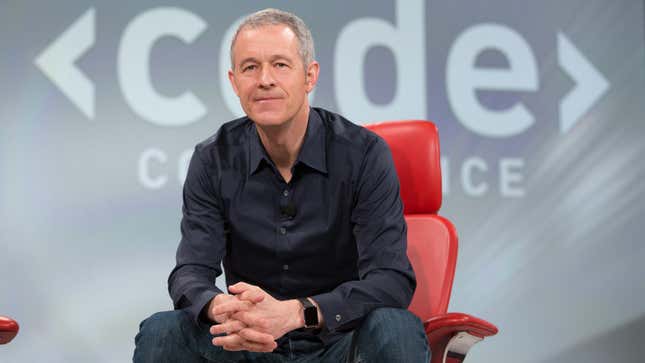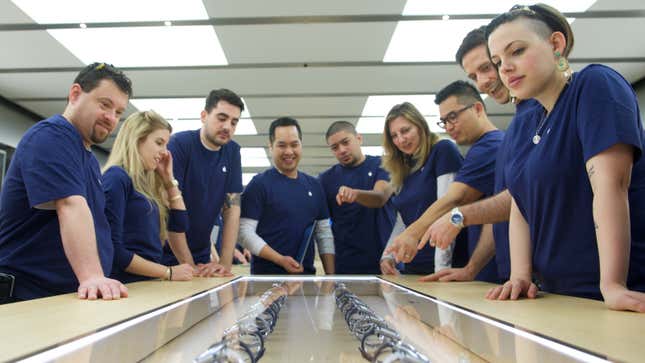Apple became the next version of itself this year.
A changing public face
Among the biggest changes was how Apple presented itself. Specifically, more of its executives spent more time in the public view, granting access, often proactively.
This year, CEO Tim Cook did a lot of interviews by Apple standards, from this month’s “60 Minutes” episode to 20 minutes with BuzzFeed in the back seat of a Cadillac Escalade. He “crashed” a coding party—conveniently while a Mashable editor was in attendance—and “wrote a message” to CNBC’s Jim Cramer. You might even say he likes the attention.
Meanwhile, Jony Ive, Apple’s chief design officer, participated in an FT profile and received the New Yorker treatment earlier this year, inviting a journalist into his Bentley. To the media, a ”rare look inside Jony Ive’s design lab” seems to be the prized new “rare look inside North Korea.” (And similarly staged.)

Jeff Williams, Apple’s newly named chief operating officer, represented the company at the Code conference, the stage where Steve Jobs made several of his rare public appearances. Two of Apple’s senior vice presidents, including long-time executive Phil Schiller, made appearances on “The Talk Show,” an indie podcast hosted by John Gruber, king of the Apple geeks.
This is in sharp contrast to the Jobs-era Apple, which doled out public appearances sparingly, opting instead for an air of mystery and opaqueness. (And it was usually only Jobs representing the company back then, and usually only to the upper crust of old, big media.)
Apple—after some criticism, and another Mashable appearance by Cook—also shuffled the lineup of executives presenting at its product keynote events, specifically to include more women. At its Worldwide Developers Conference in June, two female executives presented: Jennifer Bailey announced updates to Apple Pay, and Susan Prescott unveiled Apple’s news-reading app. Later in the year, Jen Folse helped unveil the new Apple TV. There’s more work to be done here, though, as Apple still shares many of Silicon Valley’s diversity problems.
New bets on the future
Apple’s last decade has been dominated by one thing: The rise of the iPhone. It may never do something that big again. Over the past four quarters, the iPhone represented two-thirds of Apple’s revenue, likely more of its profits, and almost all of its growth.
But this year, Apple shipped two bets on the future, revealing the new technology markets it finds most appealing.
The biggest was the Apple Watch, which went on sale in April, and has done pretty well—not great, not terribly—since then. The Apple Watch was an audacious bet on unfamiliar territory for Apple: a bet that people would want to wear computers on their wrists, and that Apple could provide the right mix of utility and fashion to lead this nascent market.

Apple has likely sold more than 5 million so far, and has probably learned many important lessons from its first version. A second take is expected in early 2016. But it might be several more iterations before something special happens, if ever. Fitbit has not been killed. Apple seems committed for now.
The second bet happened later in the year, when Apple shipped its latest Apple TV streaming box.
With it, Apple declared that it believes apps are the future of TV. For the first time, there is an Apple TV App Store, including games, and developers are free to try to reinvent how people spend their time in the living room. (One of Apple’s key concepts, a streaming television service, has reportedly been shelved for now due to stalled negotiations with television networks.)

The stakes aren’t super high here. But a lot of money runs through the television, so if Apple can become the leading software platform, that’s a good position to be in. The top free apps on the US App Store on Christmas Eve reflect a bit of the future and a bit of the past: a Pac-Man game, a 360-degree video app, and apps for HGTV, Netflix, and HBO.
Bigger picture: It’s rare for Apple to launch new platforms, especially two at a time—in a year that the company also shipped new versions of iOS and Mac OS X, a new iPhone, the iPad Pro, and a new MacBook design.
Indeed, one of the criticisms as Apple does more things is that it’s increasingly sloppy, and its customers are suffering. Apple Music, also introduced this year, was notoriously buggy and remains overcomplicated. Many sounded the alarms about slipping software quality for Apple. But all-in, it’s doing pretty well.
At Apple’s scale, neither the Apple Watch nor Apple TV hardware businesses are likely to become big revenue growth drivers any time soon. And if either or both fail, it won’t sink the company. But they’re important bets on the future that Apple can win—or lose.
The road ahead
One of the big questions for 2016 is whether Apple can keep growing at such a staggering pace. The smartphone boom is reaching maturity, and many on Wall Street have projected tepid growth—or even shrinkage—for the iPhone business next year. Overall, the current consensus is for Apple to grow overall sales 4% in its 2016 fiscal year, which ends next September. That would represent a significant slowdown from fiscal 2015, when Apple grew 28% year-over-year.
Key questions include whether Apple can continue taking share from Android, whether a new iPhone hardware subscription can accelerate replacement sales, and whether the China market, which has driven much of Apple’s growth, can keep going. Apple’s supposed car project isn’t likely to kick in for several years, so for now, the iPhone is going to have to do most of the work.
Meanwhile, Apple’s stock price has ended up around the same place where it started this year, reflecting the market’s concerns. (By comparison, Amazon shares more than doubled this year.)
In many ways, the new Apple—and this year’s activity—reflects that it has simply grown up. It’s now semi-transparent about how it works, is grooming executives in public with a pretty clear succession plan, has pending growth concerns, and even issues a stock dividend and buys back shares. Apple is just like any big corporation now.
